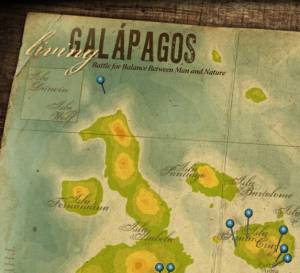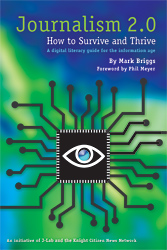Editor’s Note: Today’s guest writer is Jake Batsell, an assistant professor in journalism at Southern Methodist University and faculty adviser to the Daily Mustang. You can read more from Jake on his blog and follow him on Twitter at @jbatsell.
By Jake Batsell
 Few of us have experienced the one-of-a-kind wonders of the Galápagos Islands. But if you’re curious and have a half-hour to kill, Pat Davison’s students can take you there.
Few of us have experienced the one-of-a-kind wonders of the Galápagos Islands. But if you’re curious and have a half-hour to kill, Pat Davison’s students can take you there.
Once you start exploring, you’ll have a hard time clicking away from “Living Galápagos,†a documentary multimedia project produced last summer by a group of Davison’s photojournalism students at the University of North Carolina.
 In my three semesters teaching digital journalism at Southern Methodist University, no multimedia project has inspired more awe and admiration from my students.
In my three semesters teaching digital journalism at Southern Methodist University, no multimedia project has inspired more awe and admiration from my students.
As you absorb the site’s vivid images, technical polish and sophisticated storytelling, you can’t help but get fired up about how this new generation of journalists can harness the Web to deliver compelling journalism.
Before departing for the islands, Davison and the students met several times with a coach from a local Web design firm to storyboard the ambitious project, which examines the “battle for balance between man and nature†through dozens of videos, audio slideshows, and panoramic 360-degree photos enhanced with natural sound and interviews.
The site also features graphics galore, including an interactive map of Charles Darwin’s landmark 1835 journey to the islands. Mood music from local artists evokes a stirring sense of place. And, with a single click, users can switch all text and audio to Spanish.
Yes, the automatic intro video can test your patience, no matter how quickly you hit the skip button. And as UNC’s Tracy Boyer pointed out in her Innovative Interactivity blog, the site needs permalinks and better navigation.
Still, it’s an impressive example of how journalism students, professors and professional coaches can collaborate on intensive digital projects. Davison brought along four multimedia professionals, each of whom coached four or five students.
“The coaches are critical to the success of the projects,†Davison told me via e-mail. “We are very careful that all of the work is student-produced, but students receive one-on one coaching time every day from myself and experienced multimedia professionals.â€
This same spirit of collaboration has sparked similar multimedia projects at University of West Virginia, Arizona State University and the Carnegie-Knight News 21 initiative. Davison has captained several such projects at UNC, including 2008’s “Andaman Rising,†which won an AEJMC “Best of the Web†award.
The one quibble I have with these projects is that they tend to be one-and-done deals. For all its beautiful storytelling, “Living Galápagos†does not provide a forum to continue the conversation through blogs or reader feedback.
When a j-school sends a group of students and faculty to Thailand, South Africa or the Galápagos Islands, I’d love to see more follow-up after the project is published. Students can keep the story alive by using these sites as a platform to build and curate online communities devoted to the meaty issues they tackled in their project.
Taking this approach also would generate follow-up story ideas. What better way to make a case for a return trip?
 Mark Briggs
Mark Briggs  Posted in
Posted in  Tags:
Tags: 




